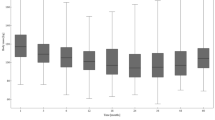Introduction: This study analyzed the influence of potentially negative predictors such as sweet-eating behavior, super-obesity, social and psychological status, family and education situation, intake of sedative drugs, and the distance between hospital and home on the outcome of laparoscopic adjustable gastric banding (LAGB). Methods: 77 women and 29 men with mean age 40.6 years (28-47) underwent LAGB. Preoperative mean body weight was 146 kg (99-179), and mean BMI was 48.1 kg/m2 (36.4-73.5). The influence of the abovementioned potentially negative predictors on weight loss was the primary end point. Results: Mean follow-up was 44.6 ± 19.7 months. Follow-up was possible in all but 6 patients. Median excess weight loss (EWL) was 52.1% (range 28.6-72.2%). Univariate analysis revealed no influence of the investigated negative predictors on the weight reduction. Median EWL in 24 sweet-eater patients was 55.6% compared to 55.4% in 82 non-sweet-eaters (P =0.65). A significant difference in the weight reduction was found between super-obese and non-superobese groups (P <0.001). Conclusions: LAGB should be recommended without limitation as the operation of choice for morbidly obese patients. Gastric bypass operations should be recommended only in cases of unsuccessful LAGB.
Similar content being viewed by others
Author information
Authors and Affiliations
Rights and permissions
About this article
Cite this article
Korenkov, M., Kneist, W., Heintz, A. et al. Laparoscopic Gastric Banding as a Universal Method for the Treatment of Patients with Morbid Obesity. OBES SURG 14, 1123–1127 (2004). https://doi.org/10.1381/0960892041975479
Published:
Issue Date:
DOI: https://doi.org/10.1381/0960892041975479




